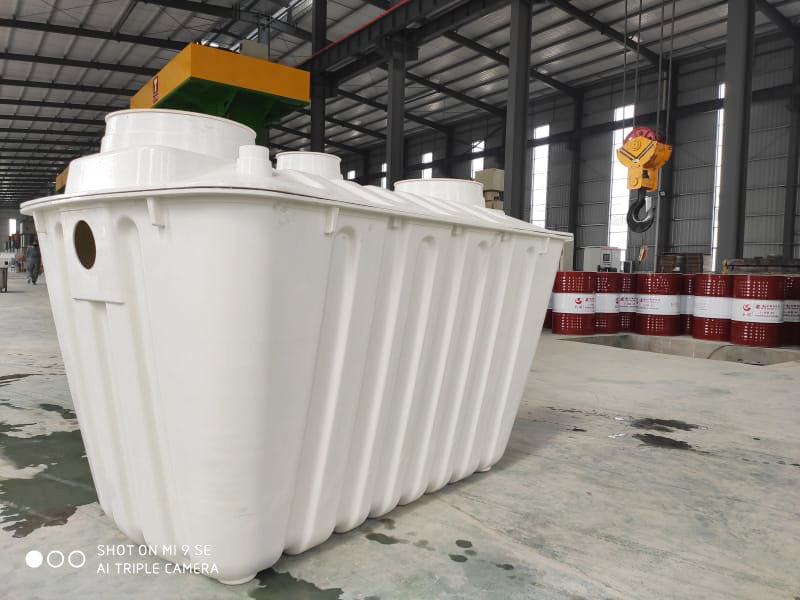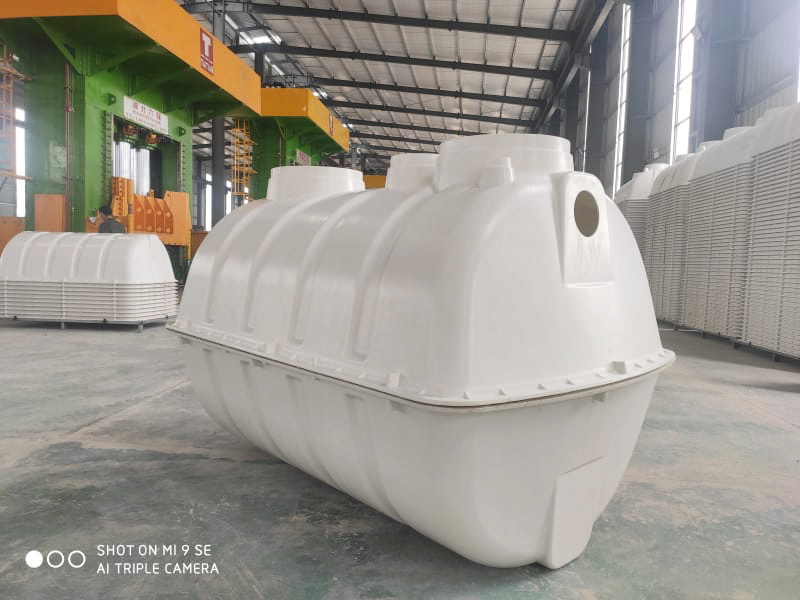FRP septic tank refers to the equipment specially used to treat domestic sewage, which is made of synthetic resin as the matrix and glass fiber reinforced materials. FRP septic tank domestic sewage purification and treatment equipment for civil buildings such as industrial enterprises' living rooms and urban residential quarters. The FRP septic tank temporarily stores excreta, which is preliminarily decomposed in the tank, so as to reduce the solid content in the discharged sewage

Construction scheme of FRP septic tank
1. The backfill meets the requirements of the construction specification. The clear cut well (inspection well) can be built on the pool body. The clear cut well has two kinds: brick built well and bench type precast reinforced concrete well.
2. In order to prevent the leakage of the brick shaft wall, the inner and outer walls of the inspection shaft are required to be plastered with 20mm thick waterproof mortar (1:2 waterproof mortar, 5% of the weight of cement), and 45% of the internal corners are plastered. The slope is 50mm thick. When there is groundwater, apply two layers of hot asphalt (or other waterproof paint) on the outer wall of the well and cover the soil to the floor requirements.

Construction precautions
1. When excavating the foundation trench, we should master the geological conditions.
2. The setting position and buried depth of FRP septic tank shall be set out and positioned in strict accordance with the design requirements.
3. After the FRP septic tank is in place, it should be backfilled in time, and the tank should be filled with water to prevent displacement. The backfill is required to be screened, free of sharp stones and construction waste. When there is no groundwater, the soil density is 0.95 and compacted. Pay special attention to filling the lower and surrounding areas of the tank with plain soil or yellow sand: when there is groundwater, fill the lower part of the tank with plain soil or yellow sand, and the fixed position of the tank is stressed evenly.
4. During construction in rainy season, there should be drainage facilities to prevent the foundation pit from ponding and slope collapse, and fill the tank with water to prevent floating and displacement.
5. The construction shall be carried out in accordance with the provisions of relevant engineering construction and acceptance specifications.

Use of FRP septic tank
The positioning and setting out of FRP septic tank products shall be determined according to the engineering design drawing, and the foundation pit can be excavated according to the selected model with reference to the given size. When the foundation pit is excavated to the predetermined elevation, the lime soil cushion shall be compacted, and the bearing capacity of the foundation shall not be less than 1ookn/ �O. The yellow sand with a thickness of 500mm-1oommm shall be used as the cushion, the large bricks and stones or choking debris contained in the sand shall be removed, leveled and compacted, and the integral septic tank shall be prepared for installation in place.
When the FRP septic tank is installed in combination or there is groundwater and the soil quality of the foundation soil is poor, it is necessary to lay pebbles or crushed stones with a thickness of 1oomm and tamp them, set a 1oomm-300mm C1O concrete cushion on the foundation, lay a 1oomm sand cushion on the concrete cushion, and fill both sides of the tank with plain soil.

Precautions for hoisting
1. The base cushion must be leveled before hoisting in place
2. Pay attention to the inlet and outlet direction of septic tank during hoisting
3. The elevation of septic tank must meet the engineering design requirements
4. After hoisting in place, adjust the part to make it level
After the FRP septic tank is hoisted in place and meets the requirements, 1/3 clear water must be poured into the tank to stabilize it, and then manually tamp it. After the FRP septic tank is in place, it should be backfilled. The lower part of the tank should be filled with sand (the height should not be less than one-half of the tank diameter). It is strictly forbidden to use construction waste as soil backfill. The stones in the backfill should be removed, and the backfill soil should be compacted in layers, with each layer connected to 30mm. It should be compacted manually. During backfilling, do not impact violently (such as air compaction), and the backfill around the tank must be dense.


